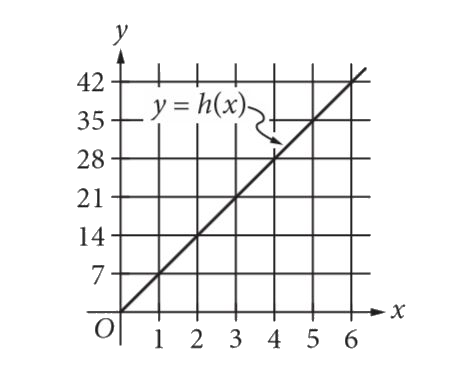
The line in the xy -plane above represents the relationship between the height h(x) , in feet, and the base diameter x , in feet, for cylindrical Doric columns in ancient Greek architecture. How much greater is the height of a Doric column that has a base diameter of 5 feet than the height of a Doric column that has a base diameter of 2 feet?
7 feet
14 feet
21 feet
24 feet
The correct Answer is:C
It’s given that the graph represents y = h(x ), thus the y-coordinate of each point on the graph corresponds to the height, in feet, of a Doric column with a base diameter of x feet. A Doric column with a base diameter of 5 feet is represented by the point (5, 35), and a Doric column with a base diameter of 2 feet is represented by the point (2, 14). Therefore, the column with a base diameter of 5 feet has a height of 35 feet, and the column with a base diameter of 2 feet has a height of 14 feet. It follows that the difference in heights of these two columns is 35 − 14, or 21 feet.
Choice A is incorrect. This value is the slope of the line and represents the increase in the height of a Doric column for each increase in the base diameter by 1 foot. Choice B is incorrect. This value represents the height of a Doric column with a base diameter of 2 feet, or the difference in height between a Doric column with base diameter of 5 feet and a Doric column with base diameter of 3 feet. Choice D is incorrect and may result from conceptual or calculation errors.
Similar Questions
The inequation that best describes the following graph is _________
View SolutionWhich inequations represent the shaded region in the given figure
View SolutionIn Fig, find the value of x.
ltimg src="https://d10lpgp6xz60nq.cloudfront.net/physics_images/PS_MATH_IX_C12_S01_032_Q01.png" width="80%"gt
View SolutionIn the following figure, if O is the center of the circle and ¯¯¯¯¯¯AB is the diameter, then find ∠ACB.
ltimg src="https://d10lpgp6xz60nq.cloudfront.net/physics_images/PS_MATH_IX_C12_E02_009_Q01.png" width="80%"gt
View SolutionMatch the followings (column I with column II)
ltimg src="https://d10lpgp6xz60nq.cloudfront.net/physics_images/NCERT_BIO_XI_C03_E01_011_Q01.png" width="80%"gt
View SolutionMatch the terms in column I with those in column II: ltimg src="https://d10lpgp6xz60nq.cloudfront.net/physics_images/NCERT_BIO_XI_C07_E01_011_Q01.png" width="80%"gt
View SolutionMatch column I with column II
ltimg src="https://d10lpgp6xz60nq.cloudfront.net/physics_images/NCERT_BIO_XI_C16_E01_002_Q01.png" width="80%"gt
View SolutionMatch column I with column II:
ltimg src="https://d10lpgp6xz60nq.cloudfront.net/physics_images/NCERT_BIO_XI_C18_E01_003_Q01.png" width="80%"gt
View Solution
